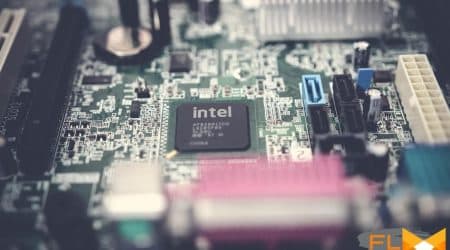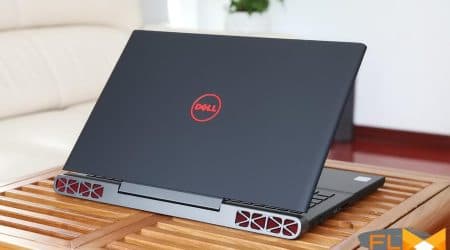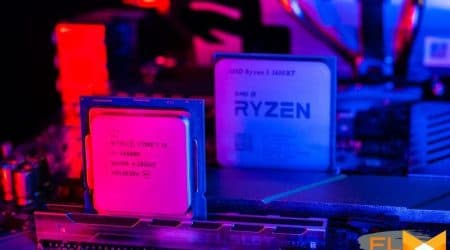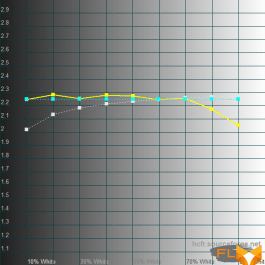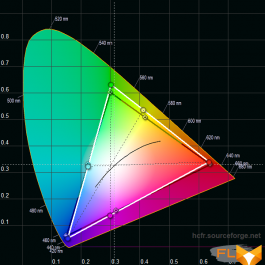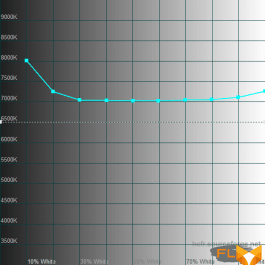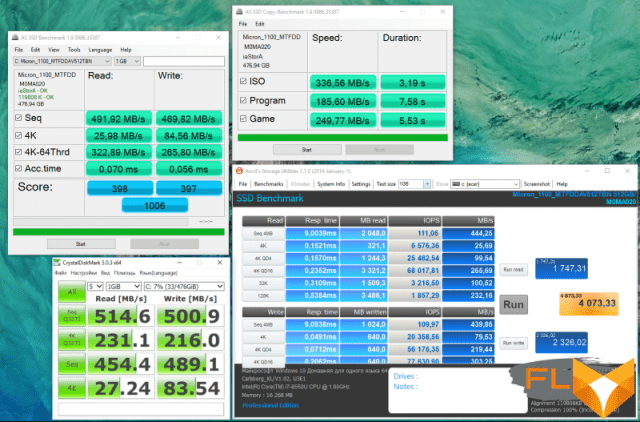


The Acer Swift 5 isn’t the first Kaby Lake Refresh CPU laptop we’ve seen. It’s time to finally get used to the fact that even the thinnest and lightest mobile devices are equipped with powerful 4-core chips. Swift 5 stands out from the crowd a little: the ultrabook is equipped with a 14-inch matrix, but at the same time its weight does not exceed one kilogram. It turns out that we have before us the ideal companion of a person who is used to working on the road? Let’s take a closer look at the novelty and see what it is capable of.
Acer Swift 5
⇡#Technical specifications, bundle and software
On sale you will find several versions of Swift 5. As you know, all felt-tip pens are different in taste and color, and therefore a potential buyer can choose among blue, black, gold and white models. You will still find models based on the previous generation dual-core Kaby Lake processors on sale, however, the table below lists only the most modern components used in various modifications of Swift 5.
| Acer Swift 5 | |
| Display | 14”, 1920 × 1080, IPS, touchscreen |
| CPU | Intel Core i5-8250U, 4/8 cores/threads, 1.6 (3.4) GHz, 15W |
| Intel Core i7-8550U, 4/8 cores/threads, 1.8 (4.0) GHz, 15W | |
| Graphics | Intel HD Graphocs 620 |
| RAM | 8GB or 16GB DDR3 |
| SSD: 256/512 GB | |
| Wireless module | Intel Wireless-AC 7265, IEEE 802.11b/g/n/ac, 2.4 and 5 GHz, up to 867 Mbps, Bluetooth 4.2 |
| Interfaces | 2 × USB 3.0 Type-A 1 x USB 3.0 Type-C 1 x HDMI 1 x 3.5mm speaker/microphone mini-jack |
| Built-in battery | 2 cells, 36 Wh |
| External power supply | 45W |
| Dimensions | 329 × 228 × 14.9 mm |
| Mass | 0.97 kg |
| Operating system | Windows 10 x64 Home |
| Warranty | 1 year |
| Price | $1,700. for test model |
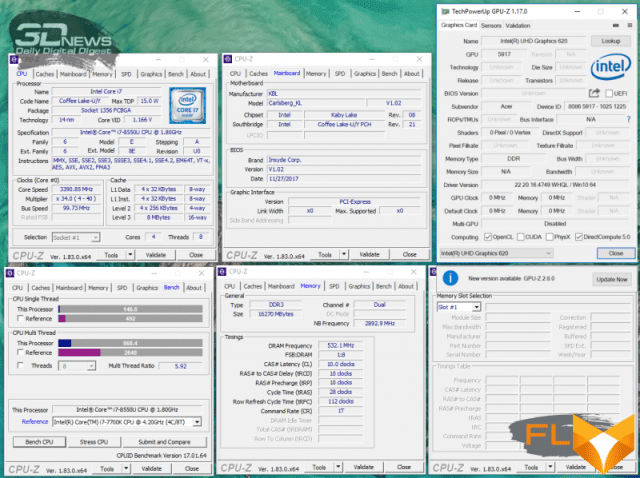
The Acer Swift 5 SF514-52T-88W1 model arrived for my test. It has a 512 GB SSD and 16 GB of LPDDR3 RAM. If you believe our computer stores, then you are getting acquainted with the most advanced version of Swift 5, for which they ask for an average of $ 1,700. At the same time, for $1,300 you can get the SF514-52T-53MB model with Core i5-8250U, 8GB RAM and 256GB SSD. For example, an HP Specter 13-af006ur with identical specifications costs an average of $1,600. Agree, the difference is noticeable.
Dealt with the pricing policy. All Swift 5s are equipped with the Intel Wireless-AC 7265, which supports IEEE 802.11b/g/n/ac standards at 2.4 and 5 GHz with a maximum throughput of up to 867 Mbps and Bluetooth 4.2.
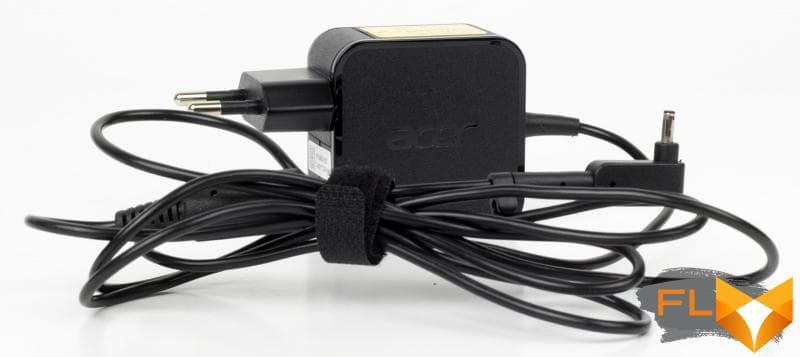
The laptop comes with a tiny 45 W power supply and weighs only 150 g. Finally, at least someone guessed to complete light devices with light accessories!
⇡#Appearance and input devices
In general terms, the look and feel of Swift 5 can be described as simple. There are no pretentious and defiant elements in the design of the laptop. But is it really that important, because before us is just a workhorse. It may seem that the body of the device is entirely made of matte plastic, but it is not. A special magnesium-lithium alloy is used, which, according to the manufacturer, increases the ductility of the material without losing strength.
I rate the build quality as excellent, there are no hacks in the work. And the blue plastic turned out to be surprisingly practical – neither fingerprints nor dust are practically visible on it.
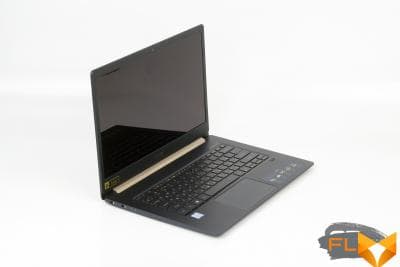 |
 |
Yes, the Swift 5 isn’t breaking records, but at 14.9mm it’s still thin. It is much more important that the ultrabook weighs only 970 grams, so you can safely take it with you anytime and anywhere. Even taking into account the external power supply in the backpack, such a burden is practically not felt.
The Swift 5 uses a 14-inch display, but when compared with case sizes, the tested model is slightly larger than ultrabooks such as the HP Specter 13 and Acer Swift 7.

The laptop lid opens 180 degrees. There are no complaints about the hinges – they accurately position the screen and prevent it from hanging out while typing. At the same time, it is impossible to open the lid with one hand.


It’s okay that Swift 5 does not compete with other models for the title of the thinnest ultrabook, because this allowed us to keep full-fledged connectors among the interfaces. So, on the left of the laptop, only a 3.5 mm jack for connecting a headset is displayed. There are also indicators of activity of the laptop and a slot for a Kensington lock. On the right side, there is a port for connecting a power supply, an HDMI output, a pair of USB 3.0 A-type and one USB 3.0 C-type.
There are no connectors on the front and back. The air is taken in by the fan through a small grill located on the bottom of the laptop and blown out through the perforation on the back wall.

The keyboard is somewhat reminiscent of the one used in older Acer models, such as the Aspire R13. Flat keys 16 × 14 mm in size have a small height and are 3 mm apart from each other. Typing on such a keyboard is quite convenient, since all the buttons are located in their places. But the keys Esc, Prt Sc, Del and the F1-F12 series turned out to be small, so you will have to get used to working with them. Inconvenient at the Swift 5 keyboard and arrow buttons, on which the functions of decreasing / increasing the sound and screen brightness are simultaneously “hung”.
The backlight of the keyboard has only one color and one level of brightness, which suits me personally. By default, the F1-F12 series works, which is actually somewhat atypical for ultrabooks, since multimedia functions are usually considered a priority. However, this also suits me.
There are no complaints about the touchpad: it is not as big as in Swift 7, but it performs its function well. The touchpad surface is pleasant to the touch, gestures are recognized normally, pressing is accompanied by a distinct and rather loud click. In operation, the touchpad behaves quite adequately – it was tested in the Gwent computer card game.
As for the webcam, the Swift 5 uses a standard 720p sensor with 30Hz recording capability, with all that comes with it. So, a picture of satisfactory quality can really be obtained only in bright sunny weather. In a room with artificial lighting, the image is very noisy. For Skype calls, this quality will be quite enough, for something more serious – definitely not.
⇡#Internal design and upgrade options
The laptop is very easy to disassemble, however, the design of the device uses screws with a Torx slot (popularly an asterisk). After removing 11 screws, it remains only to carefully remove the bottom.
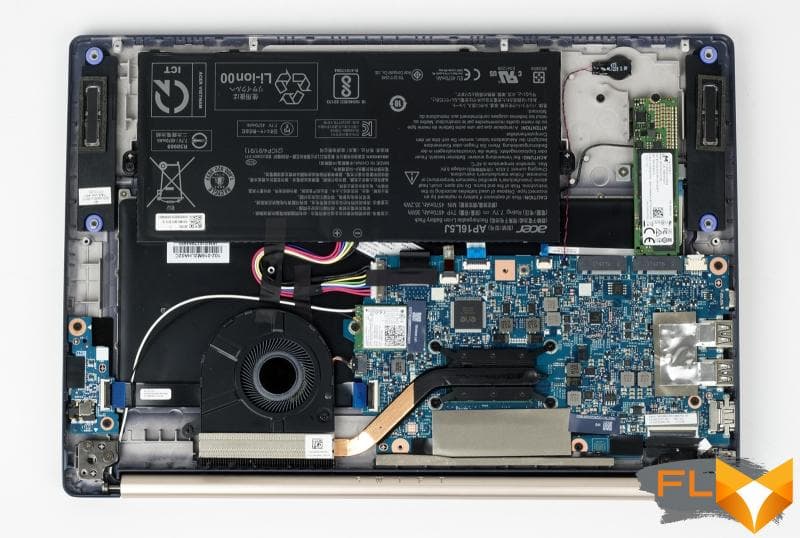
As is often the case in ultrabooks, most of the internal space is occupied by the battery. The Swift 5 uses two 4670 mAh cells with a rather unusual voltage of 7.7 V. A small cooling system is responsible for dissipating heat from the Core i7-8500U, consisting of a single heat pipe, a tiny aluminum heatsink and a tangential fan.
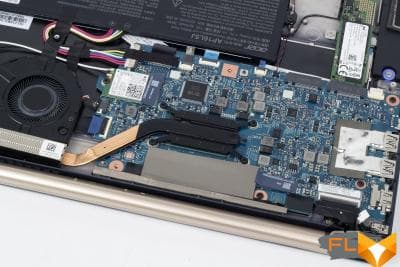 |
 |
16 GB of RAM soldered directly to the motherboard. Somehow it will not work to increase the capacity of RAM, and that is why it is better to immediately take a model with 16 GB. The system uses DDR3-2133 RAM.
It only makes sense to disassemble the laptop yourself if you want to replace the SSD over time. In the test model, a Micron 1100 MTFDDAV512TBN with a capacity of 512 GB is installed in one of the two M.2 connectors. This SSD runs in SATA 6Gb/s mode, although the Swift 5 motherboard supports PCI Express devices. The presence of a second port for installing another 2280 form factor drive is an indisputable advantage of this device.
⇡#Test Methodology
Since the laptop uses an integrated video card, there is no point in testing the device in modern AAA projects. And so it is clear that HD Graphics 620 will not do it. Nevertheless, on the Acer Swift 5, as at the time on the Specter 13, we ran the following games in Full HD resolution:
- World of Tanks EnCore. Built-in benchmark. Minimum quality. No anti-aliasing.
- Dota 2. Match recording. Low quality. No smoothing. DirectX 9
- Gwent. Witcher. Card game”. Party with computer. High quality. No anti-aliasing.
- Counter-Strike: Global Offensive. Map “Mirage” with bots. Low quality. No anti-aliasing.
Gaming performance was measured using the well-known FRAPS program. With its help, we get the rendering time of each frame. Then, using the FRAFS Bench Viewer utility, not only the average FPS is calculated, but also the 99th percentile. The use of the 99th percentile instead of the minimum frames per second is due to the desire to clean up the results from random bursts of performance that were provoked by reasons not directly related to the operation of the main components of the platform.
CPU and memory performance was measured using the following software:
- Corona 1.3. Testing rendering speed using the renderer of the same name. Measures the build speed of the standard BTR scene used to measure performance.
- WinRAR 5.40. Archive a folder of 11 GB with various data in RAR5 format and with the maximum degree of compression.
- Blender 2.79. Determination of the final rendering speed in one of the popular free packages for creating three-dimensional graphics. The duration of building the final model from Blender Cycles Benchmark rev4 is measured.
- x265 HD Benchmark. Testing the speed of transcoding video to the promising H.265/HEVC format.
- CINEBENCH R15. Measuring the performance of photorealistic 3D rendering in the CINEMA 4D animation package, CPU test.
The display was tested using the X-Rite i1Display Pro colorimeter and the HCFR app.
The battery life of the laptop was tested in three modes. The first load option – web surfing – involves alternately opening and closing the tabs of the Computeruniverse.ru and Unsplash.com sites with an interval of 30 seconds. This test uses the Google Chrome browser with the “Block data and cookies from third-party sites” and “Do not allow sites to save data” options enabled. In the second mode, x265 (HEVC) video is played in a standard Windows 10 player with the repeat function activated. The third type of load is running the Unigine Heaven benchmark at maximum graphics quality settings in full screen mode. In all three cases, the same display brightness was set to 180 cd/m2.
In games and other applications, the results of the following laptops are presented:
| Test participants | ||||||
| Model | Screen | Processor | RAM | Graphics | Drive | Battery |
| HP Specter 13-af008ur | 13.3”, 1920 × 1080, IPS | Intel Core i7-8550U, 4/8 cores/threads, 1.8 (4.0) GHz, 15W | 16GB DDR3-2133 Dual Channel | HD 620 | SSD 512 GB PCI Express x4 2.0 | 4 cells, 43.7 Wh |
| ASUS FX570UD | 15.6”, 3840 × 2160, IPS | Intel Core i7-8550U, 4/8 cores/threads, 1.8 (4.0) GHz, 15W | 16GB DDR4-2400 Dual Channel | NVIDIA GeForce GTX 1050 4GB GDDR5 | HDD 500GB 5400rpm + SSD 256GB SATA 6Gb/s | 3 cells, 48 Wh |
| Acer Swift 5 | 14”, 1920 × 1080, IPS | Intel Core i7-8550U, 4/8 cores/threads, 1.8 (4.0) GHz, 15W | 16 GB DDR3-1066 Dual Channel | HD 620 | SSD 512GB SATA 6Gb/s | 2 cells, 36 Wh |
⇡#Display and Sound
The screen bezels on the Swift 5 are no bigger and no smaller than other ultrabooks. Since we are dealing with a touch screen, its surface is glossy, with all the ensuing consequences: fingerprints, smudges, dust on the screen and glare. If you believe the official website of Acer, then on sale you can find a version of Swift 5 without a touch layer, but with the same glossy finish.
In the case of our model, an AUO203D IPS matrix from AU Optronics is used – the same panels are found in the HP Pavilion 14 and Acer Aspire R14 models. The screen has a high contrast ratio for an IPS matrix – 1417: 1, and the color temperature is kept around 7000 K. The gamma is somewhat overestimated – 2.25 against the standard 2.2. The minimum brightness is 14 cd/m2, the maximum is 238 cd/m2. Given the glossy finish, there are concerns that it will be difficult to work with a laptop, for example, outdoors on a bright sunny day.
|
Gamma |
Gamut |
Color Temperature |
The display is calibrated at an average level. The average deviation on the gray scale is 3.13 (maximum – 7.26). In the ColorCheker test, which uses 24 color patterns, the average error was 3.52. For normal use, such matrix parameters are not critical, but I would not recommend Swift 5 to designers and artists.
As in the case of other IPS matrices, you can’t get away from the Glow effect: it is clearly visible on a black field, but you practically don’t notice it on color images. There is no PWM or its frequency is too high for the human eye to notice – the LED backlight used can be classified as a Flicker-Free solution throughout the entire operating range. The declared viewing angles – 178 degrees vertically and horizontally – correspond to reality.
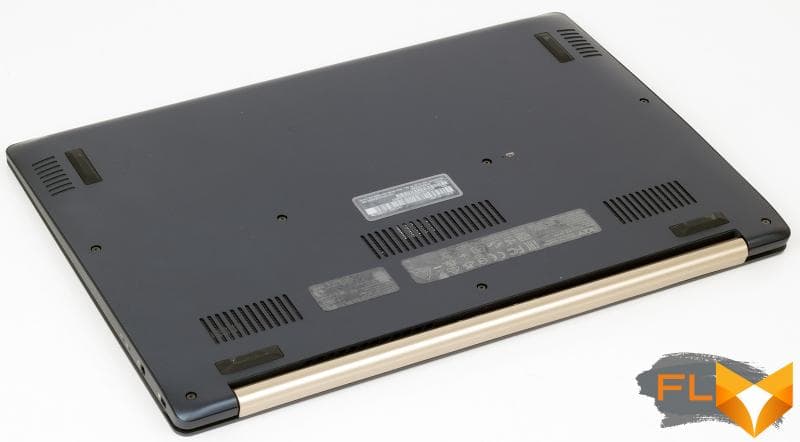
Two speakers are located on the bottom of the laptop, closer to the user. The manufacturer claims to support the Dolby standard, but in fact the sound of Swift 5 is inexpressive. The acoustics have an average volume margin, but no wheezing or other artifacts were noticed at the maximum. At the same time, the speakers clearly lack bass, so that the musical compositions sound very flat and … tasteless, or something.
⇡#Temperature, frequencies and noise
The quad-core Core i7-8550U has four physical cores and supports Hyper-Threading technology. The frequency of this chip varies over a wide range, but when all four cores are loaded, it should be 3.7 GHz – this is how Turbo Boost technology works.
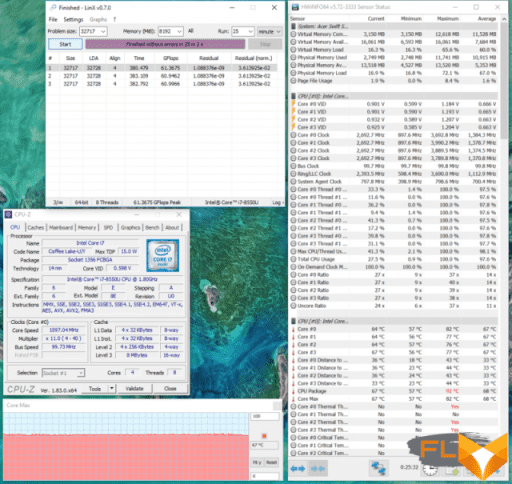
Using the HP Specter 13 and ASUS FX570UD laptops as an example, we found out that the Core i7-8550U will not work at such a frequency under load. At the same time, the processor does not overheat, but in programs of the LinX caliber it reaches the power limit very quickly. In Swift 5, this quad-core chip is seriously “cut” – after a few seconds, its frequency drops to 1.1 GHz. In this operating mode, the temperature of the hottest core reaches 68 degrees Celsius, and the noise level, measured from a distance of ~ 30 cm, is 39.9 dB. The laptop is audible, but its operation can be called quiet. I think Acer engineers sacrificed the performance of the chip on purpose for the sake of low heat, quiet operation and, looking ahead, long battery life.

Let’s not forget that programs like LinX and Prime95 are very heavy on the CPU and RAM. Ordinary applications that we use every day are not capable of this. And yet baptism by fireLinX testing is done to determine what a laptop’s cooling system can do under the most critical conditions. For example, when encoding video, the frequency of the Core i7-8550U already drops to 1.4 GHz – this is still below the nominal parameter of 1.8 GHz. At the same time, the temperature of the processor under load remains at the same mark – 68 degrees Celsius.
The screenshots above show that in LinX the peak temperature of the chip was 82 degrees Celsius, and in x265 Benchmark – 91 degrees Celsius. Such short-term temperature peaks are obviously associated with the inertia of the cooling system, since there is a short period of time between the load applied to the central processor and the start of active operation of the fan.
⇡#Performance of the processor, RAM and disk subsystem
It is also obvious that the Core i7-8550U, operating at lower frequencies, will noticeably yield to its counterparts, but at a normal frequency. However, the Swift 5 is well ahead of ultrabooks that use chips such as the Core M7-6Y75 and Core i7-7500U. For example, in the CINEBENCH R15 benchmark, the test model was 35% faster than the HP Elite X2 G1.
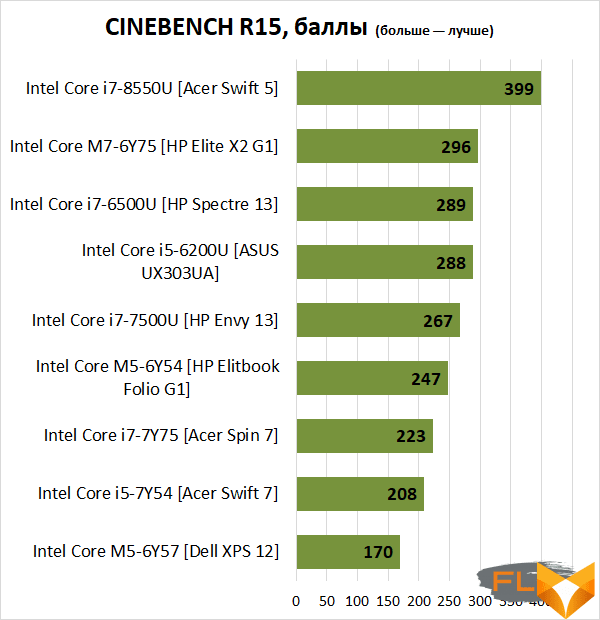
However, the Swift 5 is noticeably inferior to the recently tested Specter 13, which has a Core i7-8550U running at 2 GHz under the same conditions. Plus, the fact that the HP ultrabook uses a faster NVMe drive is affecting.
| Intel Core i5-7300HQ (HP Omen 17) | Intel Core i7-8550U (HP Specter 13-af008ur) | Intel Core i7-8550U (ASUS FX570UD) | Intel Core i7-8550U (Acer Swift 5) | Performance decay, % (relative to HP Specter 13 model) | |
| Corona 1.3, s (less is better) | 452 | 450 | 323 | 611 | -26 |
| WinRAR 5.40, s (less is better) | 693 | 576 | 516 | 608 | -5 |
| Blender 2.76, с (less is better) | 493 | 367 | 289 | 545 | -33 |
| x265 HD Benchmark, FPS (more is better) | 12,2 | 9.7 | 11,3 | 6,7 | -45 |
| CINEBENCH R15 points (more is better) | 511 | 498 | 654 | 399 | -25 |
SSD performance
As we have already found out, Swift 5 has a Micron 1100 MTFDDAV512TBN SSD, which operates in SATA 6 GB mode. For its class, this drive demonstrates quite a typical level of performance. A volume of 512 GB (real – 476 GB) will be quite enough for an ultrabook, and if desired, a second SSD can be installed in this model, which greatly simplifies the upgrade process.
⇡#Graphics Performance
Playing modern resource-intensive computer games on an ultrabook is, let’s say, a rather peculiar occupation. So, the test results in the 3DMark Time Spy benchmark show that the HD 620’s integrated graphics capabilities are not enough to do this comfortably.
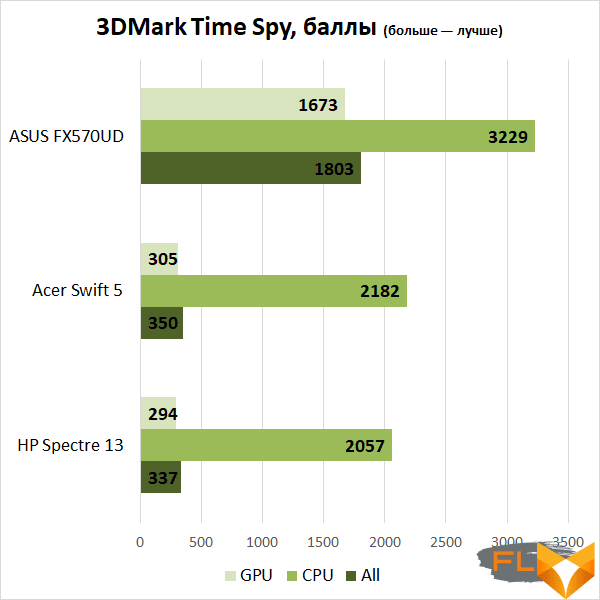
And yet, passing a few hours in Dota 2 or Tanks is quite real. Naturally, in Full HD resolution, you will have to twist the graphics quality settings to a minimum.
| HD 620 (Acer Swift 5), Games, Full HD, FPS | |||||||||||||||
| Dota 2 min. quality | Counter-Strike: Global Offensive, min. quality | “Gwent. Witcher. Card game”, high quality | WoT EnCore, min. quality | ||||||||||||
| Min | AVG | Min | AVG | Min | AVG | Min | AVG | ||||||||
| 25 | 45 | 9 | 30 | 29 | 40 | 54 | 101 | ||||||||
⇡#Work Offline
Inside the Acer Swift 5 is a 36 Wh dual-cell battery. The manufacturer claims that the ultrabook is able to work on a single battery charge up to 8 hours. This is not entirely true, but the test sample has good autonomy. In modes such as watching videos and surfing the web, the battery will definitely last for six hours. If you reduce the brightness of the screen and turn off the Wi-Fi module, then this parameter is quite realistic to increase by another two to three hours. The same HP Specter 13 does not know how.
| Battery life, 180 cd/m2 | |
| Web (opening tabs in Google Chrome) | 6 hours |
| View video (x265, HEVC) | 6 hours 14 minutes |
⇡#Conclusions
The tested model has a lot of advantages. To begin with, the laptop received a practical magnesium-lithium alloy body, as a result of which the 14-inch model weighs less than a kilogram. At the same time, the Acer Swift 5 has a comfortable keyboard and a long battery life. All these advantages make it an excellent device for work on the road. The target audience of this ultrabook looms quite clearly: active people who are not tied to the shackles of an employment contract to the workplace, who nevertheless need a tool to access the Internet and work with documents.
The advantages of Swift 5 include such parameters as quiet operation under load and the absence of overheating of the central processor. However, these advantages were achieved due to a noticeable reduction in the performance of the Core i7-8550U. On the one hand, the operation of the chip at a noticeably lower frequency does not affect the performance of tasks typical of an ultrabook – web surfing, working with office applications and watching videos. On the other hand, there are quite a few users who want to get the most out of the Core i7-8550U, and Swift 5 won’t work for those people. In this situation, the most offensive thing is that the manufacturer does not divide the chips into those that operate at the declared frequencies, and those that are noticeably “cut” for the sake of less heat and noise, but greater autonomy.
In the review, I often compared the Swift 5 with the Specter 13 ultrabook. I note that the Acer model is noticeably cheaper not only on this HP device, but also on models such as the Dell XPS 9370 and Lenovo ThinkPad T480s. Therefore, the cost of the tested version can also be added to the list of advantages of this laptop.


